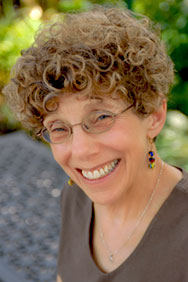"M" Is for the Million Things She Gave Us
 January 25, 2008
January 25, 2008 In a follicle in the body of a maternal fruit fly or mouse or human being lies an egg cell.
This egg cell is immense compared to the sperm that may eventually fertilize it. A sperm must race vast distances to arrive at the egg in time to compete with millions of other sperm for the fertilization prize, the chance to pass its genes to future generations. So a sperm carries only necessities: a nucleus with the genes packed into chromosomes, high energy molecules and energy-releasing structures to power the long race, a flagellum to swim with, enzymes to dissolve the egg’s protective covering and to signal that this sperm is now fertilizing the egg, and no other sperm may enter.
Once fertilized, the egg cell will divide repeatedly to produce a hollow ball of many identical cells, which will then layer themselves to start developing into an embryo. These early cell divisions happen so fast, the new cells have no time to grow before they divide again. Therefore, except for their chromosomes, which duplicate in full sets before each division, the new cells’ substance and internal structures are all portions of the original egg. So a mother animal must produce an egg large enough to provide all this material.
Next, how do the hundreds of identical new cells wind up becoming different parts of an embryo? How do they turn into head, middle, tail, top, bottom, sides, limbs? We don’t know for sure, but certain clues suggest that the maternal reproductive system conveys this body architecture. Before the egg cell leaves the follicle, molecules from the mother’s body diffuse into it. These molecules are concentrated at one side of the egg, so when the fertilized egg repeatedly divides, some of the new cells will contain a lot of the maternal molecules, and some will contain few or none. So already, the many new cells are not identical. Inside the new cells which contain them, the maternal molecules may produce proteins, and the proteins may signal the new cells to specialize in being the head-end of the embryo. Once these head-end cells specialize, they manufacture their own signals to send to other new cells farther downstream in the incipient embryo, telling them to become the embryo’s mid-section. Then the mid-section cells signal the tail-end cells. Once all these groups of cells start to specialize, they can signal within the group for finer and finer anatomical details.
So like it or not, we owe a lot to Mom. biology,
biology,  chromosome,
chromosome,  egg cell,
egg cell,  embryo,
embryo,  enzyme,
enzyme,  fertilization,
fertilization,  flagellum,
flagellum,  follicle,
follicle,  genetics,
genetics,  science writer,
science writer,  sperm,
sperm,  wonder
wonder 
